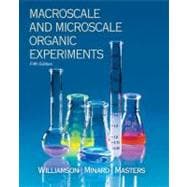
Note: Supplemental materials are not guaranteed with Rental or Used book purchases.
Purchase Benefits
What is included with this book?
| Introduction | |
| Introduction | |
| Laboratory Safety, Courtesy, and Waste Disposal Techniques | |
| Melting Points and Boiling Points | |
| Recrystallization | |
| Distillation | |
| Steam Distillation, Vacuum Distillation, and Sublimation | |
| Extraction | |
| Thin-Layer Chromatography: Analysis of Analgesics and Isolating Lycopene from Tomato Paste | |
| Column Chromatography: Fluorenone, Cholesteryl Acetate, Acetylferrocene, and Plant Pigments | |
| Gas Chromatography: Analysis of Alkene Isomers | |
| Infrared Spectroscopy | |
| Nuclear Magnetic Resonance Spectroscopy | |
| Mass Spectroscopy | |
| Ultraviolet Spectroscopy, Refractive Indices, and Qualitative Instrumental Organic Analysis | |
| Computational Chemistry Elimination, Substitution, and Addition | |
| The SN2 Reaction: 1-Bromobutane | |
| Nucleophilic Substitution Reactions of Alkyl Halides | |
| Radical Initiated Chlorination of 1-Chlorobutane | |
| Alkenes from Alcohols: Cyclohexene from Cyclohexanol | |
| Bromination and Debromination: Purification of Cholesterol | |
| Dichlorocarbene Oxidation and Reduction | |
| Oxidation: Cyclohexanol to Cyclohexanone; Cyclohexanone to Adipic Acid | |
| Pulegone from Citronellol: Oxidation with Pyridinium Chlorochromate | |
| Oxidative Coupling of Alkynes: 2,7-Dimethyl-3,5-octadiyn-2,7-diol | |
| Catalytic Hydrogenation | |
| Sodium Borohydride Reduction of 2-Methylcyclohexanone: A Problem in Conformational Analysis | |
| Epoxidation of Cholesterol Aromatic Substitution and Elimination | |
| Nitration of Methyl Benzoate | |
| Friedel-Crafts Alkylation of Benzene and Dimethoxybenzene; Host-Guest Chemistry | |
| Alkylation of Mesitylene | |
| The Friedel-Crafts Reaction: Anthraquinone and Anthracene | |
| Friedel-Crafts Acylation of Ferrocene: Acetylferrocene | |
| Reactions of Triphenylmethyl Carbocation, Carbanion, and Radical | |
| 1,2,3,4-Tetraphenylnaphthalene via Benzyne | |
| Triptycene via Benzyne Reactions of Aldehydes and Ketones | |
| Aldehydes and Ketones | |
| Dibenzalacetone by the Aldol Condensation | |
| Grignard Synthesis of Triphenylmethanol and Benzoic Acid | |
| The Wittig and Wittig-Horner Reactions Reactions of Carboxylic Acids, Esters, and Amines | |
| Esterification and Hydrolysis | |
| Acetylsalicylic Acid (Aspirin) | |
| Malonic Ester of a Barbiturate | |
| Amines | |
| The Sandmeyer Reaction: 1-Bromo-4-chlorobenzene, 2-Iodobenzoic Acid, and 4-Chlorotoluene | |
| Synthesis and Bioessay of Sulfanilamide and Derivatives | |
| Dyes and Dyeing | |
| Martius Yellow The Diels-Alder and Related Reactions | |
| Diels-Alder Reaction | |
| Ferrocene [Bis(cyclopentadienyl)iron] | |
| p-Terphenyl by the Diels-Alder Reaction | |
| Tetraphenylcyclopentadienone | |
| Hexaphenylbenzene and Dimethyl Tetraphenylphthalate Derivatives of 1,2-Diphenylethane: A Multistep Synthesis | |
| The Benzoin Condensation: Catalysis by the Cyanide Ion and Thiamine | |
| Nitric Acid Oxidation; Preparation of Benzil from Benzoin; and Synthesis of a Heterocycle: Diphenylquinoxaline | |
| Borohydride Reduction of a Ketone: Hydrobenzoin from Benzil | |
| The Synthesis of 2,2-Dimethyl-1,5-dioxolane; The Acetonide Derivative of a Vicinal Diol | |
| The 1,4-Addition: Reductive Acetylation of Benzil | |
| Synthesis of an Alkyne from an Alkene; Bromination and Dehydrobromination: Stilbene and Diphenylacetylene | |
| The Perkin Reaction: Synthesis ofa-Phenylcinnamic Acid | |
| Decarboxylation: Synthesis ofcis-Stilbene Photochemistry | |
| Chemiluminescence: Syntheses of Cyalume and Luminol | |
| Photochemistry: The Synthesis of Benzopinacol Natural Product Chemistry and Biochemistry | |
| Carbohydrates and Sweeteners | |
| Biosynthesis of Ethanol | |
| Enzymatic Reactions: A Chiral Alcohol from a Ketone and Enzymatic Resolution of DL-A | |
| Table of Contents provided by Publisher. All Rights Reserved. |
The New copy of this book will include any supplemental materials advertised. Please check the title of the book to determine if it should include any access cards, study guides, lab manuals, CDs, etc.
The Used, Rental and eBook copies of this book are not guaranteed to include any supplemental materials. Typically, only the book itself is included. This is true even if the title states it includes any access cards, study guides, lab manuals, CDs, etc.